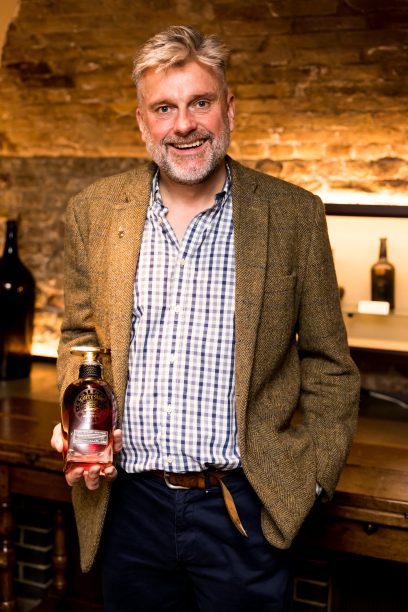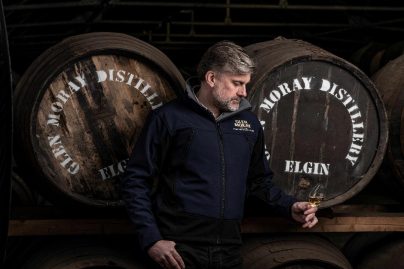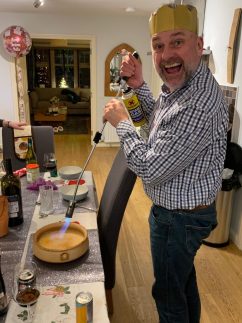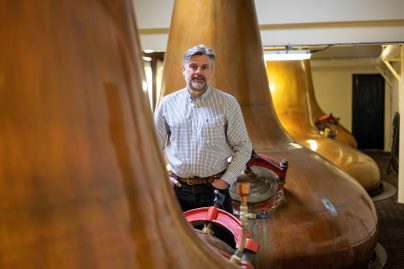30.11.23
Interview with Stephen Woodcock: Head of Whisky Creation & Stocks – Glen Turner Co. (La Martiniquaise)
Hello everyone
Following the events to celebrate the 100th birthday of the Cutty Sark blend in September, I thought it would be good to interview Stephen Woodcock, Head of Whisky Creation & Stocks at Glen Turner, the Scotch Whisky arm of La Martiniquaise-Bardinet. It was Stephen who created the special Cutty Sark Centenary Edition mentioned in my end-September piece and of which I am now a proud and privileged owner. Waiting for just the right time to open and share with those who will appreciate it.
Stephen and I met again recently over a slightly wobbly Teams connection but the audio bit was clear.
 I began by asking Stephen to tell us where he was born and brought up. The answer was the Ayrshire town of Kilwinning right at the start but brought up in Beith also in Ayrshire where, as I commented, there are a couple of whisky industry warehouses. That‘s where Stephen‘s relationship with whisky began as his Mother worked for Ballantine‘s (as did I, but in HQ, so was never fortunate enough to meet the lady) and his Dad owned a pub, „So there‘s always been alcohol of some description there.“
I began by asking Stephen to tell us where he was born and brought up. The answer was the Ayrshire town of Kilwinning right at the start but brought up in Beith also in Ayrshire where, as I commented, there are a couple of whisky industry warehouses. That‘s where Stephen‘s relationship with whisky began as his Mother worked for Ballantine‘s (as did I, but in HQ, so was never fortunate enough to meet the lady) and his Dad owned a pub, „So there‘s always been alcohol of some description there.“
Stephen‘s background before Scotch Whisky was in the chemicals industry and he somewhat pre-empted my next question about how he got into that by saying that when you‘re young you tend to think you know better than your parents so he ignored the whisky industry and followed another path for a number of years. Some of this was an inherited trait from his Dad who was, he told me, „a left-field person“ who went to university in the days where you got your name in the local paper when you graduated. So his Dad went off to study chemical engineering at Strathclyde University, graduated „..bought a copy of the paper with his name in it, framed that and promptly bought a pub!“
Stephen himself did realise after some years that sometimes your parents also speak a lot of sense and he made a move from a chemical company to Diageo. I wondered if it was a big leap from one industry to the other. „Yes and no.“ He was involved with organic chemistry and rightly pointed out that distilling is an easily understandable chemical process at its most basic. Then a week before he started at Diageo he was asked what he knew about coopering, “..which I could write on the back of a stamp, obviously“ and, „The challenge started there. That really piqued my interest and made me understand that to get anywhere in whisky you have to keep learning and keep developing. If you stop you stagnate quite quickly.“ Agreed.
He was placed at Dundashill Cooperage, „learning from the ground up“ and which, he told me, „…taught me a lot about people. I knew nothing about coopering, had never been a cooper but you needed to get these people onside with you and understand them rather than just coming in and dictating. It was a hugely interesting time.“ After that Stephen moved on to Port Dundas grain distillery, describing himslef as „a bit of a jinx“ as Diageo then closed it. That provided the chance to move north into malt distilling in the shape of Inchgower on Speyside and is a distillery he says will forever hold a place in his heart. This was a distillery he describes thus, „If you took its constituent parts and threw them out of a plane at 30,000 feet, that was how it looked and operated“. One of his jobs was to justify its overhaul as it had rather been off Diageo‘s radar for a while. Therefore it was, effectively, rebuilt in a more useable form while he was there which was also a good learning experience. „What better way to learn about malt distilling than if you strip a distillery back to its bare, beating heart. Putting it back together in a format that works.“ Kind of like breaking down the Lego and then building it back up again in a better way.
In 2009 Stephen decided to get a formal qualification from the Institute of Brewing & Distilling, the standard intro one. He mentions being „a bit late to the game“ on this. He passed that and left the studying alone for a while until his wife, who also worked in whisky, challenged him to do the diploma, which she was also doing, which was, as he says, a bit unusual. „So it became more competitive to see who could return the highest annual grade.“ Seems Mrs. Woodcock is no longer in the whisky industry but heads up technical operations for a renewables company and is involved in distillation. The company takes distillery by-products and turns them into biofuel. „So she‘s certainly the brains of the outfit“, is how Stephen compares them. „I just make things that people like to drink, hopefully.“
People do move companies in our industry but I was keen to know about the move from Diageo to Distell and then on to the Glen Turner Co. „A multitude of reasons really but I‘d hit a bit of a glass ceiling at Diageo. You always feel you have more to give. There were fewer opportunities than I felt I was capable of and Distell came knocking and that gave me the opportunity to look after Deanston, Tobermory and Bunnahabhain. That was hugely interesting as they are much more traditional processes. Diageo‘s were all very automated.“ Three good distilleries but which Stephen feels (and others would agree) that were under-invested so it was a good opportunity to see that process and understand how you can influence developments. „ I probably learned more there in 5 years than in all my time at Diageo. It was there that the passion for distilling was kept going. I was given the position of Master Distiller which is a title very overused these days. I‘m not a great one for titles. Then when Kirstie McCallum moved on that gave me the opportunity to explore stocks and blending and you realise you‘ve maybe got a wee bit of a skill for it.“
 So on to Glen Turner where Stephen joined in only March 2021. Why there? „It was two-pronged. In 2020 I had some health issues which brought home the pressure managing Operations can have and I was really hooking into and enjoying the inventory management part . So when an opportunity comes along that‘s 100% inventory management and blending with none of the stress of Operations management, it just sounded the right thing to do.“ I wondered, having been there since only 2021, when he had started work on such an important project as the Cutty Sark Centenary Edition (pic below) – a major showcase for a globally known blend. You‘d think something like that would take a long build up and lots of discussion, but no. „I started it in March 2022. I tested positive for Covid on the day of the first meeting about it so I was bundled off home, still living on Speyside at the time, but determined to have the meeting. At the relevant time I had reached Dundee so pulled over to have the meeting by phone in the shadow of Shackleton‘s ship moored there. That hint of the sea from the Tay and talking about the brand‘s rich maritime past were inspirations.“
So on to Glen Turner where Stephen joined in only March 2021. Why there? „It was two-pronged. In 2020 I had some health issues which brought home the pressure managing Operations can have and I was really hooking into and enjoying the inventory management part . So when an opportunity comes along that‘s 100% inventory management and blending with none of the stress of Operations management, it just sounded the right thing to do.“ I wondered, having been there since only 2021, when he had started work on such an important project as the Cutty Sark Centenary Edition (pic below) – a major showcase for a globally known blend. You‘d think something like that would take a long build up and lots of discussion, but no. „I started it in March 2022. I tested positive for Covid on the day of the first meeting about it so I was bundled off home, still living on Speyside at the time, but determined to have the meeting. At the relevant time I had reached Dundee so pulled over to have the meeting by phone in the shadow of Shackleton‘s ship moored there. That hint of the sea from the Tay and talking about the brand‘s rich maritime past were inspirations.“
Stephen did tell us at the 100th birthday events about the brief for this special bottling and fairly loose as I recalled but I asked him to  remind us about it. „That conversation was very short. It was just, “Go and make a nice whisky“. We considered everything. The number 23 kept coming back to me. 1923 was the year of the blend‘s creation and 23rd was the birthday of the artist who designed the original label.“ This led to a look through the mature stocks and a parcel of 1999 casks was highlighted. It had been maturing in sherry for 18 years and then port for a further five – a 23 year old Glen Moray. „The company gave me access to some beautiful single malts and grains.“ The result was an extremely rich batch of single malt which „We had to round off and soften the edges“. The single malts were blended with grain whiskies of the appropriate age and then put back into port casks for 100 days. Stephen advises some of the malts and grains used went back to the 1970‘s. 23 years was the age of the youngest whisky used in the blend.
remind us about it. „That conversation was very short. It was just, “Go and make a nice whisky“. We considered everything. The number 23 kept coming back to me. 1923 was the year of the blend‘s creation and 23rd was the birthday of the artist who designed the original label.“ This led to a look through the mature stocks and a parcel of 1999 casks was highlighted. It had been maturing in sherry for 18 years and then port for a further five – a 23 year old Glen Moray. „The company gave me access to some beautiful single malts and grains.“ The result was an extremely rich batch of single malt which „We had to round off and soften the edges“. The single malts were blended with grain whiskies of the appropriate age and then put back into port casks for 100 days. Stephen advises some of the malts and grains used went back to the 1970‘s. 23 years was the age of the youngest whisky used in the blend.
I wondered about the profile of this special edition in relation to the usual Cutty Sark style i.e. is there any common DNA in them in terms of malts and grains. „Oh, this is completely different. We don‘t like to call it easy-drinking but our traditional Cutty Sark is light and floral and is so drinkable. Tradition wasn‘t in the brief here. I gravitated to what I like and I like rich, deep, complex malts. There were chocolate and nuts and more in the malts but they were so intense we wanted to round them off a wee bit.„ I mentioned I like that kind of flavour profile too having been brought up early in my whisky career on The Glendronach and that I do enjoy Bunnahabhain which Stephen worked on at Distell. „Oh, for me the Bunnahbhain 18 , if I‘m given a free rein and off-piste is my favourite whisky.“ At this point I had to say my final question is always about my interviewee‘s desert island whisky and so had to ask Stephen to park that one just in case he changed his mind by the end!
 What is the biggest challenge in your current job? Anything not in the company portfolio that you‘d like to see – are you hankering after an island distillery for example?! „Volume! La Martiniquaise for the biggest part is a commodities business. I‘m looking at 20 million litres of alcohol a year and you have to have the right volume and the right wood at the right time which is a phenomenal juggling act. But good fun. It‘s these kind of jigsaw puzzles that I really like.“ I mentioned the great expressions out of Glen Moray in the last few years amongst the excellent brands Stephen works on. „We‘re barely scraping the tip of the iceberg with Glen Moray. I‘m meeting the marketing team in the next few days and I‘d like to push that brand architecture up the way. We‘ve kind of stopped at 21 years and we also have the Classic range which is great to work with but I‘d like to see something older from the stock we‘ve got, 30 and 40 years old and pushing 50. Some of the casks are just beautiful.”
What is the biggest challenge in your current job? Anything not in the company portfolio that you‘d like to see – are you hankering after an island distillery for example?! „Volume! La Martiniquaise for the biggest part is a commodities business. I‘m looking at 20 million litres of alcohol a year and you have to have the right volume and the right wood at the right time which is a phenomenal juggling act. But good fun. It‘s these kind of jigsaw puzzles that I really like.“ I mentioned the great expressions out of Glen Moray in the last few years amongst the excellent brands Stephen works on. „We‘re barely scraping the tip of the iceberg with Glen Moray. I‘m meeting the marketing team in the next few days and I‘d like to push that brand architecture up the way. We‘ve kind of stopped at 21 years and we also have the Classic range which is great to work with but I‘d like to see something older from the stock we‘ve got, 30 and 40 years old and pushing 50. Some of the casks are just beautiful.”
Anything not in the company portfolio that you‘d like to see – getting to play with an Islay for example? „It would be nice maybe to have a distillery renowned for peat. A little bit is produced at Glen Moray mainly for Label 5 and Sir Edward‘s. Without giving anything away, we‘ve been making peated spirit at Glen Moray for 12 years now.” So, maybe something there to look forward to in the future. „It would be nice to do something with a bit more history in peat because I did enjoy some of the work we did at Distell with Bunnahabhain and Ledaig.“
Time to enquire what Stephen likes most and least about his job. „ Interesting question! How do I word this? Well, you associate Germany with well-engineered things; Switzerland with clocks and watches; Belgium with chocolate and in my days with Diageo the managing director asked me what got me out of my bed in the mornings. I was quickly able to say that I‘m one of only about 125 people on the planet who do what they do which is managing a Scotch Whisky distillery so I think it‘s the passion that goes with being involved in something so high profile and world-renowned. It‘s the pinnacle. I think it was Nick Morgan who called it Scotland‘s gift to the world.“ Least? „Trying to make this jigsaw all fit together! [Laughing.] There‘s no day that I get up and think I couldn‘t face my work. I love it. In Operations there‘s always the stress of what happens if you drop a malt mash; how you are going to make that volume up; what happens if the boiler breaks down and the spare part is 800 miles away and so on. The job I do now, the work I can leave on my desk when I leave after 5 is still there in the morning. I‘m enjoying it now more than ever.“
Are you one of those whisky creators who gets to travel a lot to speak about your whiskies? „No. We have Iain Allan for that. I did with Distell as they didn‘t have Brand Ambassadors. It was great. I saw a lot of the world, met lots of lovely people, people you‘ll consider lifelong friends but covid stopped that. Having moved elsewhere now I realise how much I don‘t miss departure lounges.“ Stephen is happy for Iain to get all the gigs there. I did point out he‘s doing the important stuff of giving Iain something to talk about. „Indeed. There‘s a lot of I, me, mine in the whisky world. This is my creation etc. but it‘s a big team effort and I‘m just happy being part of that team.“
 But do you enjoy the public speaking ? I ask as you did a grand job at the Cutty Sark 100th Birthday events. „It doesn‘t phase me at all. I don‘t script my talks which makes employers nervous about what I might say next! Because whisky is all about stories I take a speech and break it down into a collection of stories and that‘s how it sits in my head.“
But do you enjoy the public speaking ? I ask as you did a grand job at the Cutty Sark 100th Birthday events. „It doesn‘t phase me at all. I don‘t script my talks which makes employers nervous about what I might say next! Because whisky is all about stories I take a speech and break it down into a collection of stories and that‘s how it sits in my head.“
Do you have the final say over all the La Martiniquaise Scotch Whiskies and do you  have some people concentrating on certain brands who report to you? „In marketing there are brand specific people. On my side I typically have free rein over all Scotch Whisky brands. A lot of people find it hard to believe but it‘s just me. The technical function, the laboratory team report in to me and I make sure they are all trained to a level of competence in nosing and in organoleptic skills so I have good back-up there.„
have some people concentrating on certain brands who report to you? „In marketing there are brand specific people. On my side I typically have free rein over all Scotch Whisky brands. A lot of people find it hard to believe but it‘s just me. The technical function, the laboratory team report in to me and I make sure they are all trained to a level of competence in nosing and in organoleptic skills so I have good back-up there.„
Do you get much chance to talk whisky with fellow creators from other places? You‘ll have ex-colleagues from other places…“ I keep in close touch with Julieann Fernandez at Distell who worked for me there and who helped me a lot, for such a young lady, in pulling together my skills; also one or two others as we‘re all horse-trading spirit for our blends“
New distilleries are springing up everywhere. Is that a gift to the blender as they‘re maybe concentrating solely on bottling as single malts? And what‘s your view on the industry health right now? „One major piece of interest is the India trade agreement. All of a sudden fewer people are wanting to talk about trading spirit. Everyone wants to hold on to what they‘ve got. I‘m not sure how that will benefit smaller distillers. It could be a good thing and a bad one. If everyone rushes towards India it will leave a vacuum. If that can be filled with good single malts quite exclusive in nature then it‘s not a bad thing for them. If that trade agreement doesn‘t come off and there‘s no vacuum that‘s not so good. Time will tell. The current fears are the prices of cereal, energy and the price of wood is becoming outrageous. If I was just coming into the industry as a new distillery, I would be worried.“
 What‘s your favourite place to visit for a) work and b) leisure? „I‘m maybe going to be a bit shallow here and say I love going back to Speyside for work. [Not at all! It‘s a great region to love.] I love visiting Glen Moray and I have some favourite distilleries there for a whole raft of reasons.“ I mentioned I don‘t get to do it so much any more but would like to. „I‘m in a transitional phase. I used to commute from Speyside to the Central Belt for about 7 or 8 years so every Monday was a 4a.m. start. I don‘t miss that part but it‘s great to go back and visit. Leisure – well, we like our holidays but I‘m very blessed. I was a keen rugby player at school and my wife is from a rugby-playing family so Murrayfield is a great place for the pair of us to go and we know we‘re going to enjoy a good day out.“
What‘s your favourite place to visit for a) work and b) leisure? „I‘m maybe going to be a bit shallow here and say I love going back to Speyside for work. [Not at all! It‘s a great region to love.] I love visiting Glen Moray and I have some favourite distilleries there for a whole raft of reasons.“ I mentioned I don‘t get to do it so much any more but would like to. „I‘m in a transitional phase. I used to commute from Speyside to the Central Belt for about 7 or 8 years so every Monday was a 4a.m. start. I don‘t miss that part but it‘s great to go back and visit. Leisure – well, we like our holidays but I‘m very blessed. I was a keen rugby player at school and my wife is from a rugby-playing family so Murrayfield is a great place for the pair of us to go and we know we‘re going to enjoy a good day out.“
Specifically about you and not work, I knew already your interests were rugby and running but you don‘t play rugby any more. Why? „My ankles, knees and hips. No major injuries though. Never badly injured apart from my nose and the usual suspects. I played at school and on a junior and senior side at weekends – so 3 games a weekend. Then in my mid-30s after one game a weekend I could barely walk till  about Wednesday. So now it‘s just a casual run 3 days a week.“ But doesn‘t running aggravate those joints too? „Not as much as an 18 stone prop!“ For those not familiar with rugby, a prop is one of the player positions and they‘re big guys. I mention my teenage rugby-playing nieces here and Stephen harks back to his wife‘s family to say that her parents and two siblings are very tall and this has passed on to his daughter who is over 6 feet tall. „My wife‘s family are rugby people and all very tall. My daughter was interested in playing further too but I did point out that with her height she‘d end up in a playing position where the person on the opposite side of the scrum just wants to hurt her. So she didn‘t pursue it much further.“ The photograph here is one Stephen shared of him and his daughter at Murrayfield, home of Scottish rugby.
about Wednesday. So now it‘s just a casual run 3 days a week.“ But doesn‘t running aggravate those joints too? „Not as much as an 18 stone prop!“ For those not familiar with rugby, a prop is one of the player positions and they‘re big guys. I mention my teenage rugby-playing nieces here and Stephen harks back to his wife‘s family to say that her parents and two siblings are very tall and this has passed on to his daughter who is over 6 feet tall. „My wife‘s family are rugby people and all very tall. My daughter was interested in playing further too but I did point out that with her height she‘d end up in a playing position where the person on the opposite side of the scrum just wants to hurt her. So she didn‘t pursue it much further.“ The photograph here is one Stephen shared of him and his daughter at Murrayfield, home of Scottish rugby.
You say you run to keep off the weight from cooking. Is that you doing the cooking and any signature dish? „ Yes, I enjoy it but my wife is a  very good and intuitive cook so I kind of pick up and pretend and learn a lot from her. I have a limited palette of dishes but really do enjoy a bit of cooking. Not as much as the eating, though. I do a fantastic risotto. Prawn risotto would be a signature. I‘m very patient. Sitting at the stove for an hour, adding the stock and stirring and drinking some wine isn‘t a problem.“ In this pic Stephen advised this is “…a crème brulee I had made for Christmas a couple of years ago and when it came to caramelising the sugar on top I couldn’t find my culinary blow torch…fuelled by liquid bravado I decided that the ‘weed flame thrower’ would do the task.” Don’t try this at home…
very good and intuitive cook so I kind of pick up and pretend and learn a lot from her. I have a limited palette of dishes but really do enjoy a bit of cooking. Not as much as the eating, though. I do a fantastic risotto. Prawn risotto would be a signature. I‘m very patient. Sitting at the stove for an hour, adding the stock and stirring and drinking some wine isn‘t a problem.“ In this pic Stephen advised this is “…a crème brulee I had made for Christmas a couple of years ago and when it came to caramelising the sugar on top I couldn’t find my culinary blow torch…fuelled by liquid bravado I decided that the ‘weed flame thrower’ would do the task.” Don’t try this at home…
Do you have any unfulfilled ambitions at work and outside work (apart from maybe captaining Scotland at Murrayfield)? „At work I‘m probably as far as I‘d like to go now. I don‘t know if there‘s anything else I‘d like to do. In the past I made sacrifices in moving around the country. Nothing I‘d like to do that takes me away from home. Outside work, I wish I‘d invested a bit more in rugby. I have played in a final at Murrayfield [not for Scotland] and framed my jersey from that. I‘m not ambitious outside of work. I play a lot of guitar too. I played in bands at school but never pursued it much beyond that so might appear in pubs yet! I don‘t want to do more with music now. I‘m more of a party guitar player these days. I learned classically and was sent to lessons when younger but that falls away and maybe comes out after a few drinks.“ I‘m loving this air of calm and contentment, despite the week day juggling of blending stocks. It‘s a life on an even keel of work and family pleasure that we don‘t all attain.
I asked if there were any plans to do more with Starlaw grain distillery output or any other good things that Stephen can actually talk  about right now. „No firm plans for Starlaw as a single grain. It might be nice but we sell huge volumes of it annually to other companies. There is other stuff I can‘t yet speak about.“ Given the good things that have happened in the last several years with Glen Moray – plus Stephen‘s view that there more exciting opportunities in their stocks – and the occasional special Cutty Sark expression, I think that gives us all something to look forward to.
about right now. „No firm plans for Starlaw as a single grain. It might be nice but we sell huge volumes of it annually to other companies. There is other stuff I can‘t yet speak about.“ Given the good things that have happened in the last several years with Glen Moray – plus Stephen‘s view that there more exciting opportunities in their stocks – and the occasional special Cutty Sark expression, I think that gives us all something to look forward to.
Now, you mentioned before, your love for Bunnahabhain 18 Year Old as your ultimate whisky but I asked you to hang fire in case you changed your mind for my final question. If I cast you away to a desert island with only one whisky what would it be? „You‘re not changing my mind. It‘s a Bunnahabhain 18 Year Old. It‘s 18 years in first fill oloroso. They just hit the ideal fruit flavour profile for me. They marry beautifully with the character of the Bunnahabhain spirit. “
There we ended, Stephen to go back to the blending and stocks jigsaw that he jokingly complained about but so obviously enjoys and I am very grateful for his time. As mentioned above, I, for one, am definitely looking forward to more flavoursome bottlings from La Martiniquaise, particularly from Glen Moray, under Stephen Woodcock‘s watch.
That‘s all for November now. Next piece will be mid-December which will include a tasting note or two plus some Christmas/New Year recommendations and maybe more.
 Till then, happy dramming.
Till then, happy dramming.
Slainte mhath,
Caroline
Comments